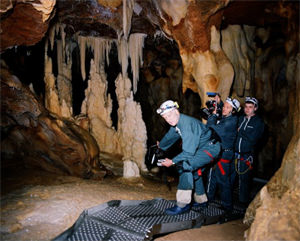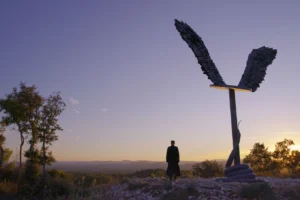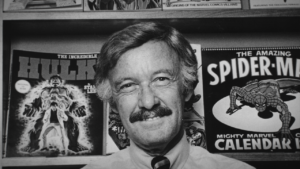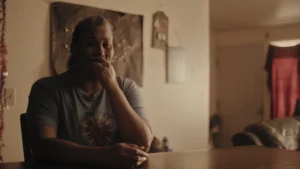Herzog Lights Up ‘Cave of Forgotten Dreams’
What I’m saying is that Herzog is a director whose work is never to be missed, for the simple reason that he takes you places—especially in his documentaries—that no other director thinks of going.Werner Herzog is cinema’s great poet of the extremes—of climate, of geography and, of course, of human behavior.
is cinema’s great poet of the extremes—of climate, of geography and, of course, of human behavior. Among his fictional films, “Aguirre: The Wrath of God” remains for me, after almost 40 years, his masterpiece—that mad conquistador floating down a nameless South American river, tormented by monkey and mutineers, Among his documentaries, “Grizzly Man” is one of the greatest movies of our era, factual or fictive — the tale of an innocent, who believed, to his ultimate sorrow, that he could befriend and trust an extremely large bear. As David Thomson writes: the film is “unforgettable —no matter how hard you try.”
What I’m saying is that Herzog is a director whose work is never to be missed, for the simple reason that he takes you places—especially in his documentaries—that no other director thinks of going. Or has probably even heard of.
His new film, “Cave of Forgotten Dreams,” is an exploration of France’s Cave of Chauvet-Pont-d’arc, recently discovered (1994) and containing paintings that were etched on its limestone perhaps as many as 32,000 years ago (there is some dispute about their dating among the scholars representing the several disciplines studying this remarkable find). Obviously, a lot of luck went into this preservation—rock slides had to seal this cave perfectly so that no air could penetrate its chambers and destroy their colors.
That said—and we must never forget how important the accidental is in preserving art (or how much we have surely lost through mischance) — the paintings as Herzog reveals them (in 3-D, which is how you must see them, even though there is a “flat” version of the film available in some theaters) are truly wondrous. We’re not talking here about Trog and his buddies scratching cartoonish images on the rocks. These are enormously sophisticated images of the animals—horses, mammoths, etc.—with which the artists shared the earth. These creatures are rendered with apparent realism and, more significantly, with a great sense of movement. In his narration, Herzog makes a comparison between these drawings and modern movie animation, and that thought is by no means misplaced. There’s a wildness in the eyes of some of these creatures that bespeaks, I think, the awe of the artists who rendered them.
And though Herzog does not, so far as I can recall, make this point, it is implicitly obvious that what we are seeing here is one of human history’s very first statements of self-conscious artistic expression—something more than mere record-keeping, an attempt to render an artist’s (or artists) feelings about the world. Unless Herzog’s camera is playing tricks, this seemingly quite modern drive to arrest the viewer’s attention extends even to the placement of some of the drawings, which are sometimes, for example, handsomely, impressively framed in the cave’s alcoves.
What we take away from this film is a sense—still not yet fully comprehended by many among us—that the artistic impulse, the need not just to reproduce reality within the framework of some aesthetic discipline but to comment upon it, is no mere adornment of societies rich enough to indulge in the mimetic, but an essential part of our humanity. There is something like a moral lesson to be taken from “Cave of Forgotten Dreams.”
On the other hand, this seems to me something of a lesser Herzog film. It appears to me that the cave is not very rich in drawings, which forces Herzog to return again and again to a relative handful of images, varied by as many angles as his expert cinematographer, Peter Zeitlinger, can devise, but still quite repetitive. Then, too, spelunking does not seem to attract the kinds of eccentric characters that enliven other Herzog films. There’s one guy who came to this work after some years in the circus who promises a unique perspective on the paintings, but he doesn’t quite pan out. This is a field apparently dominated by scholarly sobriety. These people are into carbon dating, and are content to leave the awe-and-wonder stuff to the divinely impressionable Herzog and his flock of faithful followers—me among them.
In an effort to add a little mystery to his story, Herzog takes us to a nearby atomic power installation, where the watery runoff from its operations is enclosed beneath a large dome. In it swim a large number of albino alligators (how they got there is never explained). Herzog wonders, voice-over, what those creatures might make of the Chauvet Cave should they escape and wander over there.
Not much, one imagines. They’re alligators, for godsake. As are we, to a certain extent. We cannot really imagine the spirit that moved the primitive people who created these images. But that does not vitiate the speculative spirit that Herzog stirs in us, forcing us to reach out across the millenniums and make a connection of sorts with them. That’s something that very few films encourage. Finally, “Cave of Forgotten Dreams,” for all its imperfections and padding, seems to me a necessary film. They were there, charcoal sticks in hand, these distant ancestors of ours, and it is beyond inspiring to recognize how long and strong the history of the artistic impulse is.
Your support matters…Independent journalism is under threat and overshadowed by heavily funded mainstream media.
You can help level the playing field. Become a member.
Your tax-deductible contribution keeps us digging beneath the headlines to give you thought-provoking, investigative reporting and analysis that unearths what's really happening- without compromise.
Give today to support our courageous, independent journalists.






You need to be a supporter to comment.
There are currently no responses to this article.
Be the first to respond.